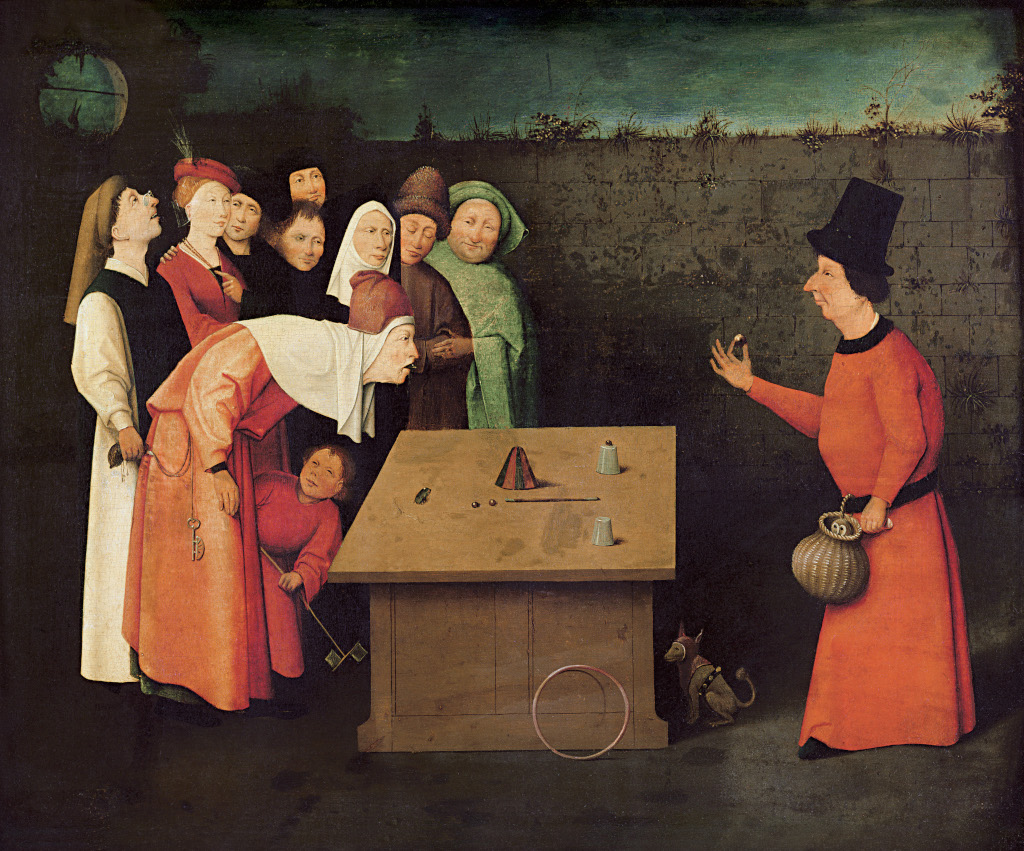The Conjuror is a lesser known artwork from around 1502, which was produced either by master Hieronymus Bosch or perhaps a member of his established studio. There were a number of different versions of this artwork produced, leading to most believing that they derived from Bosch's studio.
Attribution
The authentic, original version of The Conjuror is likely to have been the one that now remains in Musée Municipal, St.-Germain-en-Laye, close to Paris, France. It may have been that Bosch produced this piece first, before asking members of his studio to roll out a number of copies that could be sold elsewhere. It has not been possible to document much information around the members of his studio because of the number of years that have passed since, but experts have been able to spot stylistic differences between some of them. Of the copies that exist, one of the finest is to be found within the permanent collection of the Philadelphia Museum of Art, although considerable alterations have been made to the background from the earlier version, with a cityscape scene replacing the flat fields and open sky. The other versions remain in smaller collections are rarely see the light of day, such is the fragility of art from over 500 years ago.
Meaning
The real meaning of The Conjuror is one of theft. Whilst spellbound by his trick, some of the crowd are removed of their valuables. The clearest symbol of that is the leaning character who loses his bag of money whilst desperate to understand the tricks being carried out in front of him. The small owl pictured in the basket represents the conjuror's intelligence. There are also frogs appearing from the fooled individual which represents how logic and reason has been lost, replaced with emotion and an impulsive excitement. Bosch was clearly being playful within this piece, but many would miss out on some of these details without looking closely, and also understanding some of the symbolism used by the artist right across his career. The wall at the back gives the impression of these "fools" being trapped by The Conjuror, who then fleeces them, one by one, using tricks of both the hand and the mind.
"...He who lets himself be fooled by conjuring tricks loses his money and becomes the laughing stock of children..."
Description
The charming composition found within The Conjuror perfectly captures the simple lives of times gone past. A skilled entertainer stands on the right hand side, ready to perform his latest trick. He is dressed in a bright orange garment with a tall black hat perched on his head. He holds something relevant to the next trick in his right hand, with a basket in the left. A small owl's head playfully appears from the basket, and this was a symbol regularly used by Bosch within his paintings. The crowd gathers to the left, eager to understand the tricks of this gentleman. One man seems particularly suspicious, leaning over to see any craft of hand that he might pull off. A child watches on. There is then a number of other figures just behind, eager to watch events but without coming out from the safety of the crowd. One can notice a good mixture of citizens within this cross-section, some of nobility and others of a strong religious connection. Bosch is explaining that the conjuror appeals to all levels of society with his entertaining practice.
Large Image
See below for a larger image of The Conjuror, with detail on the figures in the foreground being particularly clear. The flat layout of this piece will remind some of the style of medieval artists, though Bosch himself was able to work in many different ways, and is respected as a particularly innovative individual. It his perhaps his colours and figurative work which impress within this artwork. It may not be amongst his most famous, and there are issues over the attribution, but will such a small oeuvre for this celebrated painter, is still retains great importance for historians and followers of his work. Our paintings section details all of the artist's major works, both triptychs and also the individual panels within each series.





